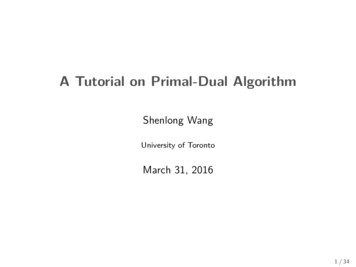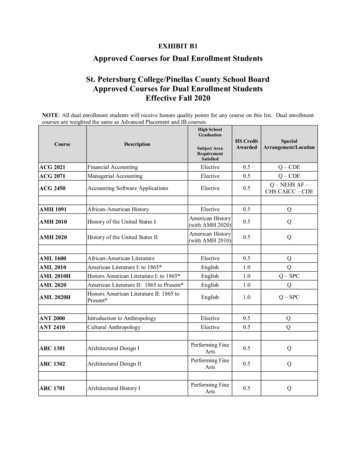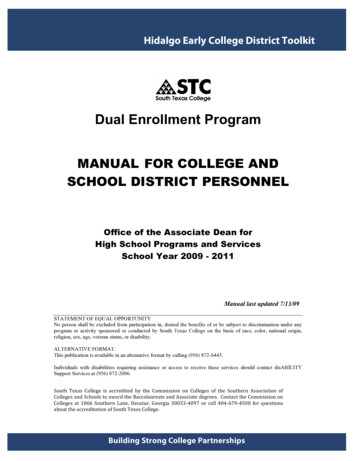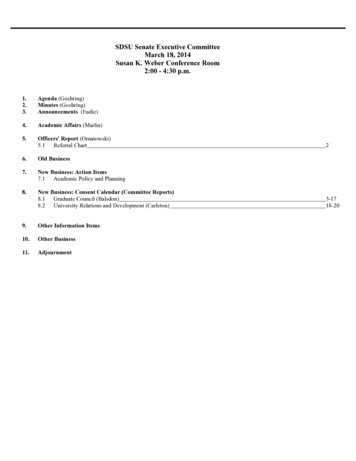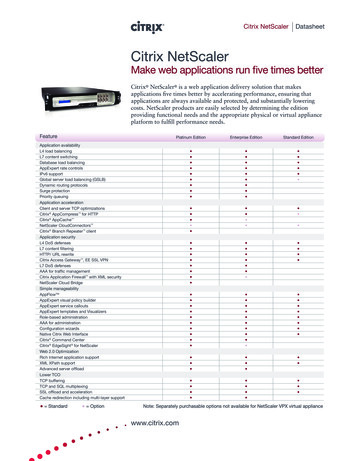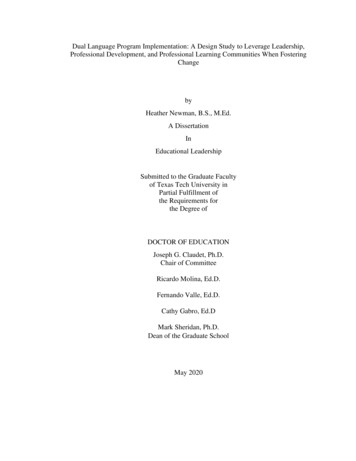
Transcription
Dual Language Program Implementation: A Design Study to Leverage Leadership,Professional Development, and Professional Learning Communities When FosteringChangebyHeather Newman, B.S., M.Ed.A DissertationInEducational LeadershipSubmitted to the Graduate Facultyof Texas Tech University inPartial Fulfillment ofthe Requirements forthe Degree ofDOCTOR OF EDUCATIONJoseph G. Claudet, Ph.D.Chair of CommitteeRicardo Molina, Ed.D.Fernando Valle, Ed.D.Cathy Gabro, Ed.DMark Sheridan, Ph.D.Dean of the Graduate SchoolMay 2020
Copyright 2020, Heather Newman
Texas Tech University, Heather Newman, May 2020ACKNOWLEDGMENTSFriendship is the instrument by which God reveals to each of us the beauties of others.C. S. LewisThe beauty of this doctoral journey lies within the friendships made and thestruggles encountered. For both, I am immensely grateful. To my cohort members –Dana, Gabe, LaShanda, Julie, Stacy, David, Dewayne, Jonathan, and Kimberly – youmade this journey worthwhile. I am forever indebted to you.To my professors in the Texas Tech Educational Leadership doctoral program,Dr. Valle, Dr. Gabro, Dr. Molina, Dr. Cardenas, and my committee chair, Dr. Claudet,thank you for you support and guidance. I am eternally grateful for your knowledge andinsight. You stretched me to consider multiple perspectives and grew me as a person andas a leader.In addition to my instructors, I would like to personally thank the participants inthe study. Sharing this experience with you as a leadership team member has not onlygrown me as a principal, but has also as an advocate for dual language education. Yourlove for bilingualism and for your students is unparalleled. A special thank you toBethany Rose for your sense of humor and willingness to go along with my crazy ideas.Your friendship is a blessing.To my friends and family who have rooted for me along the way, I have felt yoursweet words of encouragement and they meant more than you know. Last, but mostcertainly not least, thank you to my husband and partner, Jimmy. You are my best friendand biggest cheerleader. I love you always.ii
Texas Tech University, Heather Newman, May 2020TABLE OF CONTENTSACKNOWLEDGEMENTS . iiABSTRACT . viiLIST OF TABLES . viiiINTRODUCTION . 1Organizational Context on the Insider Action Research Study . 3Background of the Professional Problem of Practice . 5Statement of the Professional Problem of Practice . 9Purpose of the Study. 10Design Parameters of the Study . 14Significance of the Study . 15Change Drivers . 16Conceptual Definitions of Study Variables and Dimensions . 18Research Questions . 20Assumptions . 20Delimitations . 20Limitations. 21Summary . 21REVIEW OF RELEVANT LITERATURE . 23Who are English Learners? . 25Bilingual Education in the United States: A Historical Perspective . 26Characteristics of Programs for English Learners . 28Dual Language Education . 31iii
Texas Tech University, Heather Newman, May 2020Guiding Principles for Dual Language Education. 32Studies on Dual Language Program Implementation . 35Leadership . 37Transformative Leadership . 42Instructional Leadership and Capacity Building . 45Distributed Leadership . 48Professional Learning Communities . 51Professional Development . 53Summary . 56Literature Review Summary, Findings, and Conclusions . 57Literature Review Summary Findings. 57Literature Review Summary Conclusions . 58METHODS AND PROCEDURES. 59Study Design: Research Goals and Approach . 59Methods . 61Instrumentation . 62Data Analysis. 67Procedures . 68Dissemination . 75Limitations. 75Summary . 76RESEARCH RESULTS . 77Impact Data Results. 80iv
Texas Tech University, Heather Newman, May 2020Participant Background and Interview Information . 80Overall Growth . 83Process Data Results and Analysis . 88Sessions One, Two, and Three: Identifying the Problem . 88Session Four: Understanding Leadership . 90Sessions Five and Six: Collaborating and New Learning . 92Session Seven: Clarifying the Goal . 93Session Eight: Moving Forward . 94Impact and Process Data Conclusions. 95Emerging Themes. 96Leadership . 96Collaboration as a Professional Learning Community . 97Conclusion . 99CONCLUSIONS, DISCUSSION, AND IMPLICATIONS . 101Introduction . 101Overview of the Study . 101Major Findings and Conclusions . 102Research Question 1 . 103Summary of Findings for Research Question 1 . 106Research Question 2 . 106Summary of Findings for Research Question 2 . 110Research Question 3 . 111Summary of Findings for Research Question 3 . 114v
Texas Tech University, Heather Newman, May 2020Conclusion of Research Questions . 114Discussion . 115District Level Considerations . 115Campus Level Considerations . 117Reflections as a Researcher . 118Implications . 119Direction for Further Research . 119Summary . 121REFERENCES . 123APPENDICESA. TEMPLATE FOR SELF-EVALUATION DATA COLLECTION ANDSCORING . 133B. INTERVIEW PROTOCOL . 147C. ADULT STUDY CONSENT FORM . 148vi
Texas Tech University, Heather Newman, May 2020ABSTRACTThis action research study explores leadership at a dual language campus,specifically how leadership impacts dual language program implementation. As thenumber of English learners continues to increase in the United States, it is necessary toestablish the impact of one-way dual language delivery models and the importance ofeffective implementation to positively impact student outcomes. This research augmentsdistrict and school leaders’ knowledge of practices that impact dual language programimplementation including facilitating professional development in professional learningcommunities using both transformative and distributed leadership practices in order togarner momentum to promote organizational change. Using design-based schoolimprovement strategies and insider action research methodological principles, themultiple phase intervention plan targets the professional problem of practice to promoteleadership and collaborative practices that will move the campus forward inimplementing the dual language program more effectively.vii
Texas Tech University, Heather Newman, May 2020LIST OF TABLES1.1Change Drivers Diagram .182.1Language Programs in the United States .303.1Professional Development Intervention Design Example .744.1Pre and Post Intervention Questionnaire Results and Growth of OnlineQuestionnaire in Strand 1: Program Structure .86viii
Texas Tech University, Heather Newman, May 2020CHAPTER IINTRODUCTIONAs the growth of English language learners continues to show striking increasesin schools across the United States, and as educators across the nation can no longerescape the accountability measures of the Every Student Succeeds Act (2015), campusand district leaders are increasingly exploring research on programs that haveundoubtedly proven to be successful in closing the achievement gap and promotingacademic success. One such program receiving widespread attention is dual languageprogramming. Research from a plethora of studies demonstrates that students in duallanguage programs perform at or above grade level on reading and mathematics tests inEnglish and close the achievement gap with their non-English speaking peers in Englishonly classes by fifth grade (Lindholm-Leary, 2012). Dual language is defined by Soltero(2016) as “a long-term additive bilingual and cross-cultural program model thatconsistently uses two languages for content instruction, learning, and communication,where students develop high levels of bilingual, biliterate, academic, and cross-culturalcompetencies” (p. 3).Dual language programs have shown great promise in increasing success forstudents both in school and beyond. Valencia (2002) states, “two-way bilingual educationappears to be the only model that places and sensitizes English speakers in a secondlanguage learning environment it also stresses linguistic integration in the classroom”(p.103). Supporting Valencia (2002), Crawford (1989) contends, “If public schoolsfollow the criteria for effective two-way bilingual education programs, then it can beaccomplished” (p.104). Rumbaut (2014) cites evidence of the impact of dual language1
Texas Tech University, Heather Newman, May 2020programs later in life, amplifying the finding that the risk of dropping out of school islower for students who are proficiently bilingual. Additionally, individuals who arebiliterate are much more likely to acquire access to job opportunities in business,diplomacy, tourism, and communication industries than monolinguals (Cloud, Genesee,& Hamayan, 2000). “By some accounts, these programs are the ‘astounding’ answer todesegregating our schools, preparing children for a transnational world, and developingsmarter thinkers” (Dorner, 2016, p. 1). Developing skills that can be utilized in schooland the workforce is a win-win.While there are many benefits of dual language programs, with the rise inrecognition and implementation of these programs across the nation comes concern abouthow to best plan for and implement them. Thomas and Collier (2004) assert theimportance of focused attention to and discussion surrounding the program model withparents, teachers, and administrators and warn that the absence of this may lead to a lackof ownership, or buy-in and fidelity to implementation of the program. Without thiscritical discussion and planning schools may find themselves struggling to move forward.Both student biliteracy and program credibility are at stake if the program is notimplemented correctly.Effective program implementation and upkeep depends greatly on the guidanceprovided by school leaders (Alanís & Rodriguez, 2008; Collier & Thomas, 2009;Freeman, Freeman, & Mercuri, 2005). Principals take on the responsibility ofinstructional capacity building through transformative leadership practices, oftenfacilitating distribution of leadership to support implementation efforts. Because the duallanguage program requires extensive training and continuous professional development2
Texas Tech University, Heather Newman, May 2020through communities of professional educators, both new and experienced educatorsmust have the encouragement of district and campus leadership for the program to besuccessful (Lindholm-Leary, 2005). Working collectively with campus and districtleaders, schools can reduce challenges that come with new program implementation.The lack of attention to the role of school leaders in the implementation of duallanguage programs is striking (Elfers & Stritikus, 2014). As new programs areestablished, an abundance of literature provides clear guidelines for preparation andplanning for such programs; however, there is little mention of the specific leadershippractices required to promote and support effective program implementation. In addition,available research on dual language programs centers primarily on program design andcharacteristics, student outcomes, cross-cultural issues, and attitudes and experiences ofstudents, parents, and teachers involved (Howard, Sugarman, & Christian, 2003). Theparticular problem facing schools, and more specifically, campus administrators, is howto cultivate distributed leadership practices and a culture of shared learning inprofessional learning communities (PLCs) that will lead to effective implementation andsustainability of the dual language program. Campus leaders, or leadership teams, needmore guidance on how to implement new initiatives and programs more effectively.Organizational Context on the Insider Action Research StudyApollo Independent School District (AISD) is a mid-sized school district inTexas, serving roughly 33,000 students. For the purpose of anonymity and for thepurpose of this study, the PK-5 elementary campus will be referred to as HillsideElementary and the district as Apollo ISD. AISD has a long and proud history ofacademic achievement, ranking in the top 10 in the nation for high achievement with3
Texas Tech University, Heather Newman, May 2020low-income-students according to the Education Equality Index (Dauter & Olivieri,2017). Empowering students to be thinkers, communicators, collaborators andcontributors is a tenet that is woven through many aspects of educational programming inthe six high school, middle school, and 37 elementary campuses in AISD. As a choicedistrict, schools in AISD are unique and offer students and families the option ofattending a campus that meets their needs, even if it’s not their neighborhood school.Students in this west Texas school district are as diverse as the neighborhoods.Almost half of students served in the district are Hispanic, followed by one third White.One tenth of the student population is African American, with the remaining tenth ofstudents being mostly Asian and two or more races. With the distinct diversity ofneighborhoods comes unique needs of families in the surrounding community. Schools inthis district are continually seeking creative ways to meet the needs of students, which iswhy three elementary campuses opted to shift from a bilingual programming model to adual language model to better serve the language needs of English Learners (ELs) andtheir families. This was a significant change since bilingual programming models hadserved students in the school district for over 40 years. One of those elementarycampuses is the focus of the current study.The west Texas elementary school is a pre-kindergarten through fifth gradecampus with a student population of an estimated 560 students. The demographics at theelementary school differ from the district as a whole, with the campus serving apopulation of 78% Hispanic, 15% White, and the remaining 7% African American,Asian, and two or more races. The school building is 70 years old, and many of theteachers on the campus have taught at the campus for more than a decade. Almost all of4
Texas Tech University, Heather Newman, May 2020the students qualify for free or reduced lunch and many families depend on communitysupport provided through the school via the campus counselor and social worker. Studentmobility is higher than the district average at nearly 15%. Students receiving specialeducation services are also higher than district averages at 15%; this could be partly dueto the inclusion of two Adaptive Curriculum Classrooms (ACC) on campus to servestudents with severe cognitive learning disabilities. Nearly half of the student populationis classified as ELs. Student discipline is slightly higher than average when compared toother campuses with similar demographics. Parent involvement and communityparticipation are below average, though the campus has attempted to increase these byincreasing family nights and improving communication from school to home. Campusmorale is average compared to other campuses of similar size and demographics.The elementary school of the current study is one of three elementary campuses inthe district implementing a one-way dual language program model. Programimplementation for the campus began in the 2017–2018 school year in pre-kindergarten,kindergarten, first, and second grade classrooms. Each year, as the children advance theschool plans to implement an additional grade level with the goal of full dual languageprogram implementation by the 2020–2021 school year.Background of the Professional Problem of PracticeThis current study will utilize design-based school improvement interventionstrategies proposed by Mintrop (2016) and insider action research methodologicalprinciples discussed by Coghlan and Brannick (2014). Mintrop’s (2016) designdevelopment logic model includes six steps: 1) defining and framing a problem ofpractice; 2) making intuitive theories of action explicit; 3) understanding the problem and5
Texas Tech University, Heather Newman, May 2020the change process; 4) designing a research-based intervention; 5) implementing theintervention and collecting data; and 6) evaluating the intervention and deriving designprinciples.To define and frame the problem of practice, an ill-structured problem wasformed initially, based on personal experiences and observations of day-to-dayhappenings at the campus. When I arrived as an assistant principal on this campus in July2018, I had never worked at a campus with such high numbers of ELs or one withbilingual classrooms. In May of the same year, I received two books about dual languageprograms and read both in order to have some knowledge of the purpose for the programand to learn how this was different from the bilingual program already in place at thecampus. As the school year began, I noticed that there was little talk of what needed tooccur to implement the program. When I asked teachers their feelings about the program,responses varied. Some were excited and others were nervous. This informal data leadme to define an ill-structured problem and became high-inference problem of practicestatement. I hypothesized the problem of practice to be that campus leaders werestruggling to implement the dual language program effectively due to the fact that theprogram model being used lacked sufficient guidance for school leaders to actuallyimplement the program. To solve the problem, my initial intuitive theory of action will beto research leadership practices that support and hinder dual language programimplementation and share the findings with school leaders to improve the implementationprocess.In order to make the intuitive theory of action explicit and move from a ‘highinference’ opinion of the problem to a ‘low inference’ statement based on observation, an6
Texas Tech University, Heather Newman, May 2020exploratory needs assessment will be conducted to identify “gaps in results or asperceived discrepancies between a current and a desired condition” (Mintrop, 2016, p.61). I began writing down observations from informal conversations with the campusprincipal and teachers. I took notes of observations at team meetings and of day-to-dayhappenings at the campus, including parent conversations in the front office, and beganlooking for evidence of dual language tenets in student work samples and classnewsletters. Additionally, I reviewed completed rubrics of dual language teachers fromthe guide titled Guiding Principles for Dual Language Education, (Howard, LindholmLeary, Rogers, Olague, Medina, Kennedy, Sugarman, & Christian, 2018).From my notes, I learned that campus bilingual teachers were familiar withtransitional bilingual programming, as this is the model that has been in place to servesecond-language learners for many years. Shifting to a new model had been met withsome resistance due to limited time to pre-plan for the program initially, a lack of Spanishinstructional resources, narrow professional development in dual language pedagogy, andmixed support from parents. While there was marked provision for the change from thedistrict bilingual director in terms of providing funding for training and resources, theabrupt exit of a key district academic leader who was instrumental in supporting programimplementation left the campus feeling uneasy about ongoing support and encouragementof the actual implementation. Responsibility for the program would likely rely on thecampus leader’s ability to communicate with district leaders to garner additional support.This is problematic because as Lindholm-Leary (2005) observed, even a very successfulprogram may collapse if it relies on a single person for leadership.Support of the dual language program at the campus was also mixed among7
Texas Tech University, Heather Newman, May 2020parents and teachers. While one parent voiced support for the model, two othersexpressed concern about their children being in dual language classrooms resulting in thestudents being pulled from the dual language classroom and placed in a monolingualclassroom. Multiple informal conversations with teachers showed various levels ofsupport for the program as well. One teacher was outspoken for the program andidentified the advantages of bilingualism for students both in school and in the workforce.Another teacher noted reluctance in believing the benefits of dual language programmingto students, yet another noted reserve in her own confidence and efficacy of instruction inSpanish. The level of positive support from parents and teachers was varied, making theirmixed levels of engagement an area of concern. Additionally, the lack of training andprofessional development in the tenets of dual language programming implementationwas noteworthy considering the relatively short amount of time allotted for pre-planningbefore actual implementation. While teachers attended conferences and receivedliterature on the model and it added to their understanding, the lack of ongoing andtargeted professional development devoted to this new program and adequateimplementation practices is a weakness.After analysis of the various data sets, the needs assessment revealed deeperinsights to the explanatory factors, surface behaviors, and underlying root causes for theprofessional problem of practice to explain the reason for the lack of articulated anddeeply embedded shared vision, mission, and purpose for the dual language program. Thefindings indicate that an understanding of dual language programming and itscomponents is unclear to staff and parents. Campus leadership, including principals andteachers, lack the necessary professional development to build collective efficacy through8
Texas Tech University, Heather Newman, May 2020shared work in PLCs. Additionally, campus leadership lacks time and specific toolsneeded to promote collaborative change through a distributed leadership model.Transformational leadership skills are also needed to promote organizational change andelicit positive engagement by teachers and parents with dual language programming.Moreover, campus bilingual staff as a whole were not ‘sold’ on the model and thereforewere not motivated or engaged in the actual implementation process. Conversations withparents and teachers indicate a lack of understanding of the basic tenets of dual languageprogramming. From the exploratory needs assessment, a refined, low-inference problemof practice statement was formed indicating a lack of articulated and shared vision,mission, and purpose for Hillside Elementary and its newly implemented dual languageprogram. In order to improve implementation efforts, campus leadership must identifycreative ways to secure positive involvement from campus staff and parents to moveforward with program implementation.Statement of the Professional Problem of PracticeThe campus leadership team, including the principal, assistant principal, and fiveteachers lacks the necessary professional development to build collective efficacythrough shared work in a PLC. Additionally, the campus leadership team lacks time andspecific tools required to promote collaborative change through a distributed leadershipmodel. Transformational leadership skills are necessary to promote organizational changeand elicit positive engagement by campus teachers and auxiliary staff with dual languageprogramming. In order to improve implementation efforts, the campus leadership teammust identify creative ways to secure positive involvement from campus teachers andauxiliary staff to move forward with program implementation.9
Texas Tech University, Heather Newman, May 2020Purpose of the StudyThere is lack of an articulated and shared vision, mission, and purpose for theelementary school of the current study’s newly implemented
Apollo Independent School District (AISD) is a mid-sized school district in Texas, serving roughly 33,000 students. For the purpose of anonymity and for the purpose of this study, the PK-5 elementary campus will be referred to as Hillside Elementary and the district as Apollo ISD. AISD has a long and proud history of
